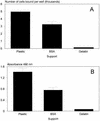Binding of Candida albicans to immobilized amino acids and bovine serum albumin
- PMID: 9423850
- PMCID: PMC107869
- DOI: 10.1128/IAI.66.1.140-144.1998
Binding of Candida albicans to immobilized amino acids and bovine serum albumin
Abstract
In this study, we examined the binding of Candida albicans synchronized yeast-phase cells to plastic, immobilized amino acids and bovine serum albumin (BSA) and quantified the binding by using an XTT tetrazolium salt assay and absorbance determination. Our results show that C. albicans binds efficiently and specifically to several nonpolar aliphatic amino acids and positively charged amino acids and to BSA immobilized on tissue culture plastic but not to polar uncharged, negatively charged, or aromatic amino acids. Adhesion of yeasts to immobilized amino acids was not affected by preincubation of cells with BSA, whereas binding to immobilized BSA was affected by preincubation of yeasts with alanine, proline, and leucine but not by arginine or lysine. The ability to distinguish the chirality of these amino acids was also examined by using both the D and L amino acid configurations, and the results show that C. albicans yeasts recognize only the L configuration of these amino acids. The observations that C. albicans specifically binds to certain amino acids indicate that these amino acids may prove useful tools for studying the binding interactions of C. albicans yeasts with host proteins such as components of the extracellular matrix.
Figures




Similar articles
-
Effect of antifungal agents on the binding of Candida albicans to immobilized amino acids and bovine serum albumin.J Antimicrob Chemother. 1999 Apr;43(4):583-7. doi: 10.1093/jac/43.4.583. J Antimicrob Chemother. 1999. PMID: 10350392
-
Adhesion of different Candida spp. to plastic: XTT formazan determinations.J Med Vet Mycol. 1996 Nov-Dec;34(6):407-10. J Med Vet Mycol. 1996. PMID: 8971630
-
Stimuli that induce production of Candida albicans extracellular aspartyl proteinase.J Gen Microbiol. 1993 Jul;139(7):1643-51. doi: 10.1099/00221287-139-7-1643. J Gen Microbiol. 1993. PMID: 7690395
-
Nutrient uptake by Candida albicans: the influence of cell surface mannoproteins.Can J Microbiol. 1999 May;45(5):353-9. Can J Microbiol. 1999. PMID: 10446710
-
Candida albicans and Saccharomyces cerevisiae expressing ALA1/ALS5 adhere to accessible threonine, serine, or alanine patches.Cell Commun Adhes. 2002 Jan-Feb;9(1):45-57. doi: 10.1080/15419060212187. Cell Commun Adhes. 2002. PMID: 12200964
Cited by
-
Systematic survey of nonspecific agglutination by Candida spp. in latex assays.J Clin Microbiol. 2007 Apr;45(4):1315-8. doi: 10.1128/JCM.01688-06. Epub 2007 Jan 31. J Clin Microbiol. 2007. PMID: 17267637 Free PMC article.
-
Degenerate peptide recognition by Candida albicans adhesins Als5p and Als1p.Infect Immun. 2004 Apr;72(4):2029-34. doi: 10.1128/IAI.72.4.2029-2034.2004. Infect Immun. 2004. PMID: 15039323 Free PMC article.
-
Candida albicans Agglutinin-Like Sequence (Als) Family Vignettes: A Review of Als Protein Structure and Function.Front Microbiol. 2016 Mar 15;7:280. doi: 10.3389/fmicb.2016.00280. eCollection 2016. Front Microbiol. 2016. PMID: 27014205 Free PMC article. Review.
-
Multiple surface interaction mechanisms direct the anchoring, co-aggregation and formation of dual-species biofilm between Candida albicans and Helicobacter pylori.J Adv Res. 2021 Mar 31;35:169-185. doi: 10.1016/j.jare.2021.03.013. eCollection 2022 Jan. J Adv Res. 2021. PMID: 35024198 Free PMC article.
-
Uses and limitations of the XTT assay in studies of Candida growth and metabolism.J Clin Microbiol. 2003 Jan;41(1):506-8. doi: 10.1128/JCM.41.1.506-508.2003. J Clin Microbiol. 2003. PMID: 12517908 Free PMC article.
References
-
- Douglas L J. Adhesin-receptor interactions in the attachment of Candida albicans to host epithelial cells. Can J Bot. 1995;73:S1147–S1153.
MeSH terms
Substances
LinkOut - more resources
Full Text Sources

